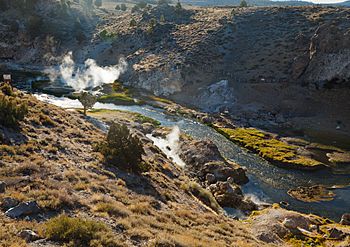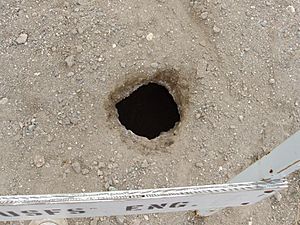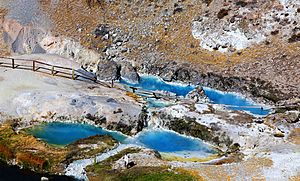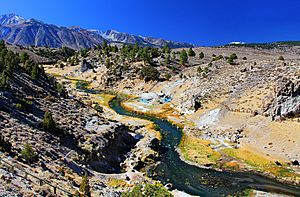Hot Creek (Mono County) facts for kids
Quick facts for kids Hot Creek |
|
|---|---|

Steam from geothermal springs rise above Hot Creek
|
|
| Country | United States |
| State | California |
| County | Mono |
| Physical characteristics | |
| Main source | Twin Lakes 8,563 ft (2,610 m) 37°37′05″N 119°00′28″W / 37.61806°N 119.00778°W |
| River mouth | Owens River 6,844 ft (2,086 m) 37°42′30″N 118°47′01″W / 37.70833°N 118.78361°W |

Hot Creek, also known as Mammoth Creek, is a cool stream that becomes warm in Mono County, in eastern California. It flows through the beautiful Inyo National Forest.
Contents
Journey of Hot Creek
Where Mammoth Creek Starts
The creek begins high up in the Sierra Nevada mountains. It starts as water flowing out of Twin Lakes, which are just south of Mammoth Mountain. This is near the town of Mammoth Lakes. The water here is mostly from melted snow and is very cold, usually below 50 °F (10 °C).
How Mammoth Creek Becomes Hot Creek
As Mammoth Creek leaves the mountains and flows east into a huge ancient volcano area called the Long Valley Caldera, something interesting happens. It meets warmer water from geothermal springs at a place called the Hot Creek State Fish Hatchery. From this point on, the stream is called Hot Creek.
Even after mixing with warm water, Hot Creek usually stays cool, below 68 °F (20 °C). But then, about 8 miles (13 km) east of Mammoth Lakes, it reaches the Hot Creek Gorge. Here, many hot springs bubble up from the ground and into the stream. This makes the water much warmer! Hot Creek eventually flows into the Owens River near Crowley Lake.
Animals and Nature at Hot Creek
The warm springs near Hot Creek are home to a special type of fish called the Owens tui chub. This fish is an endangered species, meaning it's very rare and needs protection. Hot Creek is one of only two places where this fish is known to live.
Scientists from the USGS have an observatory nearby called the Long Valley Observatory. They keep a close eye on the springs, checking water temperatures, how much water flows, and the chemicals in the water. They also monitor the activity of the ancient volcano in the caldera.
Understanding the Hot Water System
The hot water at Hot Creek comes from deep underground. Rain and snowmelt from the mountains soak into the ground. This water goes down several kilometers (or miles) where it gets heated by hot rocks. The rocks are heated by the ancient volcano under the Mono–Inyo Craters.
This superheated water then rises back up through cracks in the ground. It flows eastward through layers of rock until it reaches the surface at Hot Creek and around Crowley Lake. As the water travels, it cools down and mixes with colder water. That's why the springs near Crowley Lake are not as hot as those in Hot Creek Gorge.
The springs in Hot Creek Gorge release a lot of hot water, about 70 percent of all the heat from springs in the Long Valley Caldera. The rocks in the gorge are often fractured because of frequent earthquakes and the ground slowly rising. These cracks allow the hot water to escape. Sometimes, minerals can seal these cracks, making the springs less active. But new cracks can form, or old ones can reopen, causing the springs to become more active again.
Visiting Hot Creek Gorge
The U.S. Inyo National Forest manages the Hot Creek Gorge area. It's a popular spot for many outdoor activities like fishing, swimming, hiking, bird watching, and photography.
Important Safety Information

The Hot Creek Gorge can be dangerous because the hot springs can change suddenly. The water temperature, how much water comes out, and where the springs are located can all shift without warning. This is why it's very important to stay on marked walkways and behind fences.
Since 2006, some springs in the popular swimming areas have been acting like small geysers. They can suddenly shoot very hot, muddy water up to 6 feet (2 m) into the air! Sometimes you can even hear "popping" sounds from far away. These geysers can erupt for a few seconds at a time, with several minutes in between. There are also fumaroles, which are steam vents, in the gorge. These can be on the ground near the creek.
Because these changes are unpredictable and dangerous, the U.S. Forest Service closed parts of Hot Creek Gorge in June 2006, and they remain closed for safety.
Hot Creek on the Big Screen
Hot Creek Gorge has been a filming location for several movies! It appeared in the 1969 film True Grit and the 1960 film North to Alaska, both starring John Wayne. It was also seen in the 1966 Steve McQueen movie Nevada Smith and the 1971 film Shoot Out with Gregory Peck.




